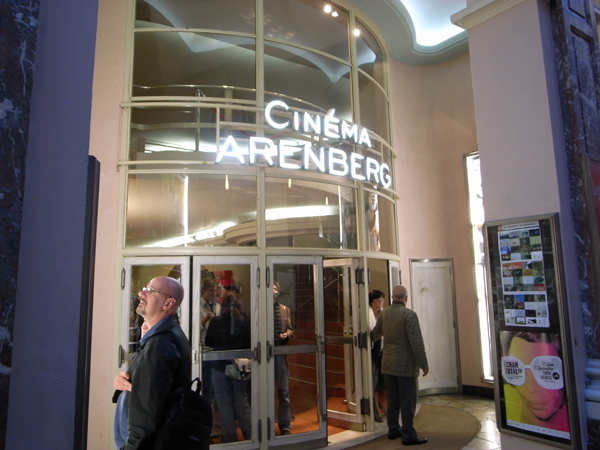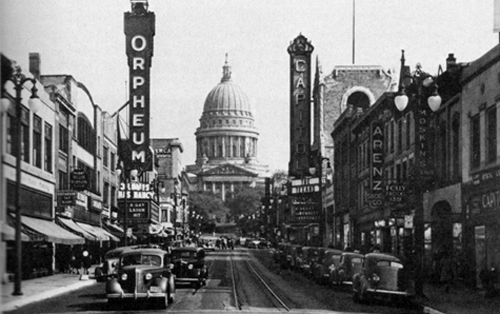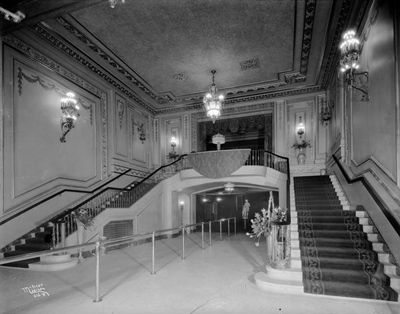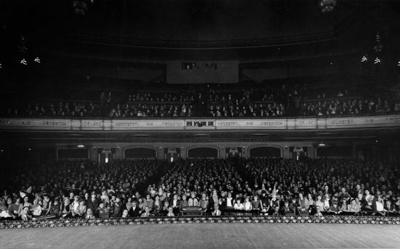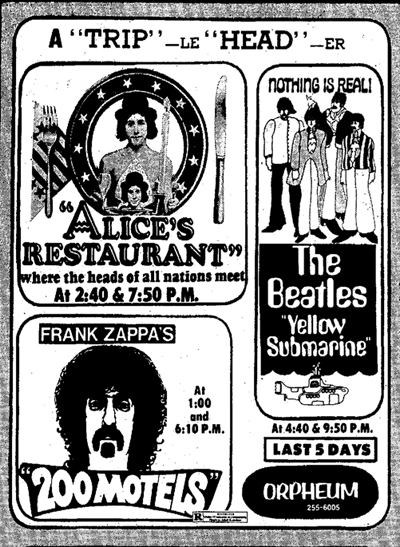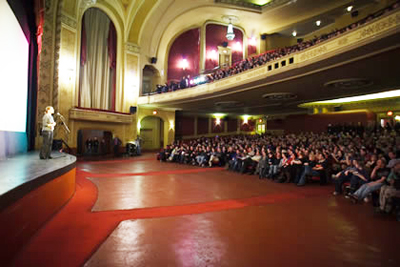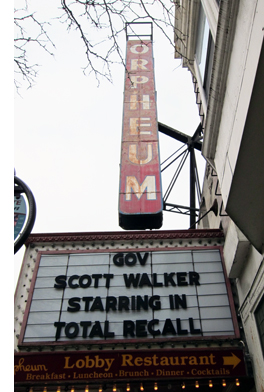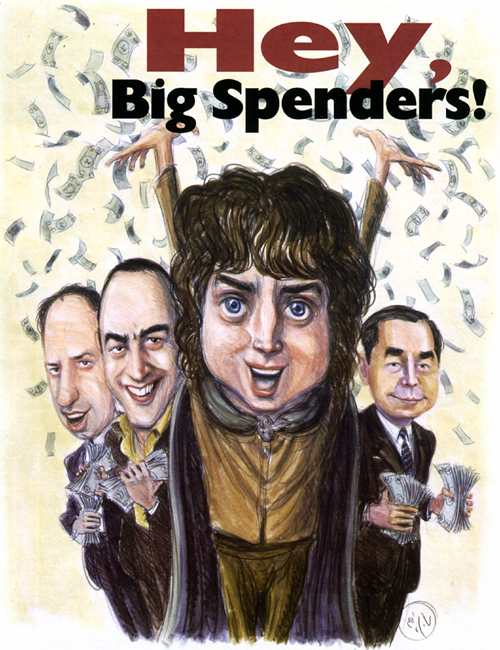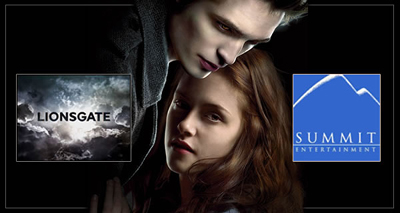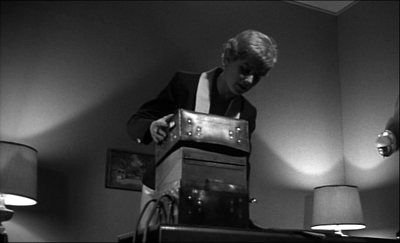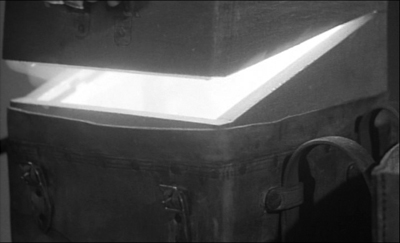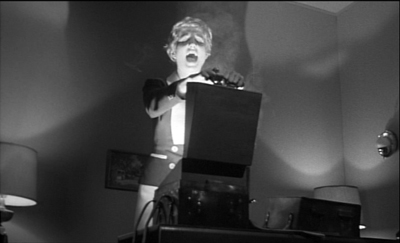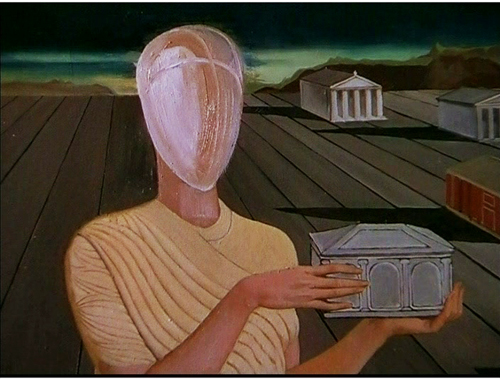Archive for the 'Film industry' Category
Digital projection, there and here
Galeries Cinéma banner, Brussels, 2012.
DB here:
The Cinéma Arenberg, in the splendid Galerie de la Reine, has long been a mainstay of Brussels film culture. Since 1939, the lovely Art Deco theatre was what we Americans call an art-house. Over the years Kristin and I visited the city, the Arenberg’s autumn and spring schedules featured recent releases, but every summer the programmers plunged into plucky repertory programs. While the multiplexes ran Hollywood blockbusters, the Arenberg provided 90 or so classics and little-known releases under the rubric of Écran Total. It was here, for example, that I saw von Trier’s The Kingdom and resaw Vanishing Point. Four years ago I left a little note about the three titles I watched during my last day in town: India Song, Serpico, and Darjeeling Limited. That trio gives you a sense of how varied and interesting the programming was.
The Arenberg closed down at the end of 2011, but the cinema has reopened under new management as Galeries Cinéma. It didn’t sponsor an Écran Total season this year. Instead it offered brand-new releases on its three screens, along with some children’s programs.
Most notable for me this time was Leos Carax’s Holy Motors. Whatever you’ve heard about this film is probably accurate. I found it an exhilarating, frustrating, and continuously provocative descent into Surrealist role-playing. It’s a tour of cinema genres and an anthology of bits of other movies, from Marey to Franju, and not forgetting Carax’s own. Especially evocative were the poetic fusions, such as the way that the body stocking Oscar dons for digital motion-capture evokes both ninja outfits and the leotards of Feuillade’s Vampires. Carax films Oscar’s SPFX exercise in a way that connects Muybridge to video games and recalls the exuberantly spasmodic scene in Mauvais Sang in which Denis Lavant races madly down the street to the accompaniment of David Bowie’s “Modern Love.”
Whether you find Holy Motors infuriating or beguiling, you won’t forget it.
Exquisitely shot on digital capture, Carax’s film was given crisp, bright digital projection at the Galeries. And speaking of digital projection. . . .
The new issue of Film History, devoted to digital technology’s impact on filmmaking and film culture, includes Lisa Dombrowski’s article “Not If, But When and How: Digital Comes to the American Art House.” It’s a very fine survey of all the issues facing the art-film community at this moment. Lisa reviews the major technological and financing conditions before going into depth on a case study of three art theatres in Miami. The author of a very good book on Samuel Fuller, Lisa knows how to tie together industrial and aesthetic issues skilfully.
Another young scholar, this one at the Free University of Brussels, has concentrated on the digital transition in Europe. Since 2005 Sophie De Vinck has been studying how the conversion of theatres fits into European film policy. The result was her 2011 thesis, “Revolutionary Road? Looking back at the position of the European film sector and the results of European-level film support in view of their digital future.” The thesis, running to a whopping 769 pages, is an immense resource, and not just for people interested in digital cinema. Sophie surveys the history of national and international support of the Western European film industry, from production through exhibition, and she provides both a broad context and very specific analysis.
Part of her argument is that the “diversity” aimed at by subsidized filmmaking hasn’t been matched by diversity in audiences. But digitization offers a new chance to show films outside the dominant forms of commercial cinema and perhaps attracted new sectors of the public. “Every innovation usually brings with it possibilities for new or smaller sector players to strengthen their competitive position.” Her examination of how digital conversion affects small and art-house venues provides a complement to Lisa’s research.
I wish I’d known about Sophie’s thesis when I was writing the blogs that became Pandora’s Digital Box, but at least I can signal her work now. Best news of all: Sophie has generously made “Revolutionary Road?” available under a Creative Commons license here as a pdf. Full of valuable statistics and well-honed observations, her work helps us understand how the contemporary European film industry has survived and sometimes flourished over the last fifty years.
Cinema Arenberg, Brussels, 2008. The original design of the curved doorway and neon sign was restored in 2005-2006.
The indispensable site Cinema Treasures has a brief entry on the history of the Cinéma Arenberg/ Galeries. More extensive information can be found in Isabel Biver’s luxurious survey, Cinémas de Bruxelles: Portraits et destins, which I wrote about in an earlier entry.
P.S. 1 August 2012: I just learned from Gabrielle Claes that Giovanna Fossati’s book on digital restoration in film archives, From Grain to Pixel, is now available for free in pdf form here. It’s well worth reading.
Orpheum descending
State Street, Madison, Wisconsin, 1927.
DB:
When it comes to film culture, Wisconsin yields to no one in weird-assery. I’ve chronicled Mad City Movie Mania on other occasions (here and here), and a current flap has just added to the annals of the addled.
It revolves around Madison’s Orpheum Theatre, a 1927 movie palace that has gone through many incarnations. In recent years it’s become mainly a music venue, but it was also fitted out with a restaurant and still showed the occasional art movie. Until it was shut down last month.
The problem is that after several years of confusion, feuding, moving money around, petty spite, and general dodginess, nobody knows exactly who owns the Orpheum. Is the owner Henry Doane, local restauranteur, who for years was publicly considered the purchaser? Is it Eric Fleming, Doane partner who became anything but silent? Is it Gus Paras, wealthy landlord and restauranteur, who bid a couple of million for it at auction last month? What of the woman who acquired Fleming’s share of the building? And the shadowy figure who made off with a plastic bag holding $175,000—how does he fit in?
“I’ve never done anything to deserve the negative treatment that I’ve been getting. I’m very compromising. I’m willing to do whatever it takes to make things work—as long as it’s profitable.” Eric Fleming
“I’ve gone through every kind of humiliation known to mankind, so I’m kind of immune to it at this point.” By 2007 the partnership had gone so sour that Doane keyed Fleming’s car in broad daylight.
Please visit the story by Steven Elbow at the Capital Times for all the details. My account will be drawing on Elbow’s patient sleuthing, but I also want to recall the glorious, not to mention the inglorious, days of this old house.
Marbles
Orpheum Theatre, 1927. Photo by Angus B. McVicar. Collection, Wisconsin Historical Society.
Designed by Rapp and Rapp, premiere theatre architects, the New Orpheum opened in 1927. (It was initially called that because it superseded the Orpheum, a vaudeville house in another part of town, which was soon renamed the Garrick and specialized in live theatre.) The New Orpheum’s lavish French Renaissance foyer swept up to a staircase leading to the balcony. The auditorium held over 2400 seats, making it the biggest theatre in town until the slightly larger Capitol was built across the street a year later, also by Rapp and Rapp.
The New Orpheum (hereafter, the Orpheum) was one of those picture palaces that aimed to elevate the filmgoing experience while also being a good community citizen. It had a corps of ushers, a smoking lounge, and a reputation for punctilious service. The theatre sponsored community events too. When the local newspaper launched a marbles tournament, the Orpheum held a screening for 2000 kids.
The kids came early and jammed the State street side of the New Orpheum, so it was necessary to call extra policemen to handle the traffic. Once inside the theatre they yelled and applauded the two comedy features which were shown for them, and practically jumped out of their seats during the showing of “Why Sailors Go Wrong.”
Six months before the 1929 stock market crash, the Orpheum was reportedly selling 20,000-25,000 tickets per week, in a town of about 55,000 souls.
An RKO town
View from the Orpheum stage, Halloween, 1930. Photo by Angus B. McVicar. Collection, Wisconsin Historical Society.
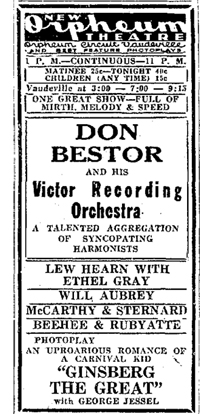 The New Orpheum and the Capitol weren’t in competition, since the Keith-Albee vaudeville circuit owned both. Both houses showed movies, but they seem to have been secondary at the Orpheum. Sometimes Orpheum ads from the late 1920s don’t even mention the titles of what’s playing. (This ad on the right is from 1928.) When talkies came in and the circuit became part of Radio-Keith-Orpheum, films became the central attraction, with live performances as filler. A 1930 kids’ party at the theatre shows the banner flying, “These Madison Boys and Girls Are on their Way to an RKO Theatre.”
The New Orpheum and the Capitol weren’t in competition, since the Keith-Albee vaudeville circuit owned both. Both houses showed movies, but they seem to have been secondary at the Orpheum. Sometimes Orpheum ads from the late 1920s don’t even mention the titles of what’s playing. (This ad on the right is from 1928.) When talkies came in and the circuit became part of Radio-Keith-Orpheum, films became the central attraction, with live performances as filler. A 1930 kids’ party at the theatre shows the banner flying, “These Madison Boys and Girls Are on their Way to an RKO Theatre.”
Despite the Great Depression, RKO moved quickly to monopolize the Madison movie scene. In 1931, the Parkway (capacity 1100) was acquired by the chain, and soon afterward RKO cut a deal with the Fox Film Corporation to take over the Strand (1400 seats). The swap permitted Fox to dominate Milwaukee in exchange for making Madison an RKO town for first-run films. Of course, in good oligopolistic fashion the RKO theatres showed films from all the studios, as did the second-run houses.
I’ve been unable to determine at what point RKO lost control of its Madison screens. [But see the P. S. below.] Presumably it was after the 1948 divorcement decrees severed Hollywood studios from control of theatres. At some point the Milwaukee entrepreneur Dean Fitzgerald acquired seven local houses, including the Orpheum, under the rubric of the Madison Twentieth Century Theater Corporation.
In 1969, a second screen was carved out of the backstage area of the Orpheum and the minuscule theatre that resulted was called the Stage Door. The contrast with the imposing classic house was startling: the Stage Door was almost certainly the worst theatre in town. Then it declined even more. By the end, with its spidery movable chairs and dank atmosphere, it was reminiscent of the storefront theatres of the nickelodeon era, except that they were surely more comfortable.
Less than heavy traffic
Capital Times advertisement, September 1973.
When Kristin and I came to Madison in 1973, we saw a sort of Sargasso Sea of old movie houses. The Majestic, a decrepit vaudeville house built on a plan as cockeyed as an Escher drawing, was showing X-rated fare, kung-fu, and double-bill repertory. It became a Landmark calendar house. A neighborhood house, the Atwood (aka the Eastwood and the Cinema), built in 1930, screened porn and kiddie shows , though not together. The Esquire also offered sex: arty (The Story of O) or not (Dr. Feelgood, with Harry Reems). The mammoth Strand was still functioning as a first-run house; Star Wars played there for months. The Middleton (seating 500 or so) was designed as a Quonset hut in 1946, and was said to have been built in a week. By our day it was playing second run. The Capitol, where I saw The Exorcist, was still operating too. Every year one theatre or another seemed to run the endlessly popular Eastwood Dollars trilogy.
The mall cinemas were emerging as single-screeners or duplexes. They got the premiere first-run pictures like The Sting, often leaving the downtown houses with lesser items. The most obvious options were counterculture movies and sexploitation.
The Orpheum went along. “Entertainment for the Entire Family!” trumpeted a 1965 Orpheum ad, but by 1969 there were revivals of Bullitt and Bonnie and Clyde. Sometimes classier items like The Godfather would show up in second run, but Orpheum fare in the early seventies was more likely to be Heavy Traffic, Enter the Dragon, The Filthiest Show in Town, revivals of headflix (see above), and a double-bill of Russ Meyer’s Vixen and Up! This was the period when the movie page of the papers included ads for This Is Heaven Sauna Massage, The Rising Sun Counseling Clinic (Adults Only), Photographic Arts Do It Yourself Nude Photography (Camera and Film Supplied), Ms. Brews Lounge (Nude Dancing Daily), and The Dangle strip club.
 One by one the theatres were closed or converted to other uses. The Capitol became part of an arts complex. The Orpheum remained the only more or less intact movie house from the old days. By 1998, Dean Fitzgerald was ready to sell it.
One by one the theatres were closed or converted to other uses. The Capitol became part of an arts complex. The Orpheum remained the only more or less intact movie house from the old days. By 1998, Dean Fitzgerald was ready to sell it.
Two forces were contending for the property. As part of a plan to revitalize the downtown area, the Madison Idea Foundation proposed putting in an IMAX facility. But preservationists objected that an IMAX setup would wreck the layout of the house. By contrast, restaurant owner Henry Doane (right) favored restoration. He proposed to rehabilitate the old place respectfully and use it for art films, film festivals, and live music. He also wanted to install an upscale café and bar.
Doane won the City Council’s approval and in 1999 he purchased the Orpheum. Throughout the 2000s, thanks to some clever programmers, it played remarkably eclectic fare, from Arnaud Depleschin ‘s A Christmas Tale to Matthew Barney’s Cremaster cycle (running two weeks, no less). In addition, Doane’s plan to revive the Orpheum as a live music venue, with booze, was finding some success. The grand house that had hosted Gene Krupa, Frank Sinatra, Bob Marley, and Journey now had popular indie bands. When local critic Rob Thomas drew up his list of ten-best shows for the decade, Orpheum concerts took five places. Most memorably, Bela Fleck and the Flecktones played to a packed house the night after the World Trade Tower attacks, highlighted by a version of “God Bless America.”
Drinks plus dining plus music kept the Orpheum doors open, but by the late 2000s the place was obviously not flourishing. There were rumors that distributors, long unpaid, were withholding films. The place was becoming disheveled, with seats broken, that stratospheric ceiling ominously peeling, and the sound system a fog of distortion.
Worse, even though most Madisonians had an affection for the old house, nobody much went there to watch a film. Things had started promisingly: Doane’s introduction to the movie business was the blistering summer of Star Wars: Episode I—The Phantom Menace and The Blair Witch Project. But that was an atypical season. During the 2000s, most of the biggest audiences showed up during the Wisconsin Film Festival. It was indeed thrilling to see the place packed out for classics like A Hard Day’s Night (introduced by Roger Ebert) and imports like The Foul King and Wilbur Wants to Kill Himself (both shown in the presence of the directors).
At some point, accommodations were made to favor the concerts: front rows were ripped out to provide dance space.
It became a wretched place to watch movies. Lobby dance parties during screenings could drown out the soundtrack. District 13 was projected within a rectangle framed by a scaffolding erected for an upcoming show. As the decade wore on, you might go to the Orpheum for music, but you didn’t go for the films.
Orpheum vs. Orpheum
Now we know a bit more about what happened behind the scenes in the 2000s. At some point Doane split ownership of the Orpheum Theatre Co. of Madison 50-50 with Eric Fleming, a real-estate and restaurant operator.
 Fleming (right) is the sort of fellow who gets called “colorful.” He first made it into the Madison press when he opened Crave, a self-consciously hip restaurant noted for its martinis. “People come here to be out and get a little dressed up,” he told one reporter. “Kind of like a ‘Sex and the City’ place.” Maybe a little too much so: A year later Fleming was charged with disorderly conduct for pouring a drink over a Crave customer and groping a female patron. In December 2008, after an altercation that started in the restaurant, one customer was killed on the street by another in the presence of a Crave bouncer.
Fleming (right) is the sort of fellow who gets called “colorful.” He first made it into the Madison press when he opened Crave, a self-consciously hip restaurant noted for its martinis. “People come here to be out and get a little dressed up,” he told one reporter. “Kind of like a ‘Sex and the City’ place.” Maybe a little too much so: A year later Fleming was charged with disorderly conduct for pouring a drink over a Crave customer and groping a female patron. In December 2008, after an altercation that started in the restaurant, one customer was killed on the street by another in the presence of a Crave bouncer.
Fleming’s business style is traced in Elbow’s article. After Fleming became co-owner of the Orpheum, a busted real-estate investment required him to pay creditors $1.5 million. Seeking to dislodge Doane, he created a new company, Orpheum of Madison, claiming that entity as the functioning business arm. He folded that into a package of assets he transferred to Ms. Olesya Kuzmenko for $175,000. “This is what I do for a living,” Fleming explains in Elbow’s article. “I create things and I sell them.”
Who is Kuzmenko, who wound up with a mammoth downtown theatre for the price of a small house on the outskirts of town? She is believed to be Fleming’s girlfriend, but beyond that little is known. She is listed on a license application as President, Vice-President, Secretary, Treasurer, Director, and sole stockholder in Orpheum of Madison. A few years before, Fleming had sold Crave to Christina Bishop, his secretary and girlfriend at the time, under the rubric of a new company Evarc (Crave spelled backward).
There were some curious incidents over these years. There were three fires at the Orpheum, at least two considered by the police to be arson. So far no arrests have been made in the cases. There was also reportedly a break-in, during which a computer was stolen. Perhaps the strangest incident involves the fate of Kuzmenko’s payment. Elbow’s article reports Fleming’s account:
He withdrew the $175,000 he got from Kuzmenko in $100 bills from his bank account, put the cash in a plastic bag and handed it over to a guy identified in court records as Marcus DaMarko, and never saw it again.
“I loaned somebody money,” says Fleming. “I loaned him some money to invest in something. I haven’t talked to him since so I don’t have the money currently.”
So, a reporter asks, you were taken?
“Essentially.”
One more for the road
Because of these maneuvers, Fleming has been running the Orpheum for over a year without input from Doane. The newest issue involves alcohol.
Wisconsin, you must understand, has a frenzied drinking culture. We lead the nation in binge drinking, drinkers per capita, heavy drinkers per capita, and drunk driving. Madison’s main downtown artery, State Street, is packed with bars and restaurants, and the UW’s reputation as a party school attracts an endless supply of youths eager to get wasted. Consequently, what state law calls “alcohol beverages” have been central to the revival of the Orpheum. To establish the lobby restaurant (above) Doane needed to serve beer, wine, and spirits. And Fleming’s cash flow in recent years has been boosted by numerous weddings, which demand booze.
But over the years, the Orpheum’s state vendor’s permit and its liquor license have become problematic. Just during the fall of 2006, the venue under Fleming’s management accumulated some 200 points of alcohol-related violations, and there was a demand that its license be suspended. Across the spring months of 2011, things became more dramatic.
In a series of appeals to the Alcohol License Review Committee of the Common Council, Fleming began to press for the Orpheum’s liquor license to be transferred to his company, Orpheum of Madison. He assured the ALRC that Doane’s original company, Orpheum Theatre Co. of Madison, would be evicted from the premises. Doane replied he knew nothing about this, and indeed he was not evicted. Moreover, he argued that Fleming was making purchases for his own company but billing their original one. And Fleming, he claimed, had changed the door locks. The ALRC, declining to step into the middle of the feud, decided to let Doane’s original company hold the license until ownership was clarified.
Auction fever
That fracas took place a year ago, but things really got going this spring. While Doane was suing Fleming to regain control of the building, the Orpheum faced foreclosure because of unpaid bills. In April it went on the auction block.
 Enter Gus Paras (right), once Fleming friend and now Fleming foe. “He sued me and cost me a lot of money,” Paras explained. “The other thing is I watched people he screwed so bad he put them on their knees.”
Enter Gus Paras (right), once Fleming friend and now Fleming foe. “He sued me and cost me a lot of money,” Paras explained. “The other thing is I watched people he screwed so bad he put them on their knees.”
Gus Paras had had many dealings with Fleming when both sought to buy property in the area. Now Paras wanted the Orpheum as well. But when the property went to auction, along with the 300 block that had also been part of the Fleming/ Kuzmenko package, Olesya Kuzmenko showed up and began bidding against Paras. In a scene reminiscent of the auction in North By Northwest, she bid the price for the Orpheum up to $1.9 million, but Paras won it for $2.25 million. She bid again on the 300 block properties, but Paras bid her up and then folded, leaving her stuck with her $2.25 million bid. But she couldn’t make the down payment, so the court gave both the Orpheum and the 300 block to Paras for $1.9 million each. However, as of this writing, the sale has not yet been consummated. A court will need to determine who actually owns the building.
In the meantime new alcohol problems resurfaced. Doane requested that the Orpheum’s state seller’s permit not be reactivated. It expired. But the Orpheum continued to sell booze. For a time it seemed that every drink poured since April 2011 had been in violation. A June 2012 story explained:
[Assistant City Attorney Jennifer] Zilavy said the Orpheum should not have served alcohol at concerts and other events. She isn’t sure if the city will pursue civil charges, which could result in a $1,000 fine for each infraction, or refer the matter for criminal charges, which could result in a fine of up to $10,000 or nine months in jail per offense.
As a result, last month the Common Council of the city declined to renew the Orpheum’s liquor license. When the police tried to serve notice of non-renewal, they were unable to rouse anyone. “It is locked up, lights out, nobody there,” reported the officer. Now, however, it seems that Fleming managed to re-activate the license fairly soon after Doane deactivated it, so it’s unclear how long, if at all, the Orpheum was serving drinks illegally.
The city later discovered that Fleming, nothing if not tenacious, was at some point granted a state seller’s permit for his new company. But as of early July the sort-of-partners remained at loggerheads. Doane’s company had a liquor license but no seller’s permit. Fleming’s company now has a seller’s permit but no liquor license. And Doane’s company’s liquor license expired last Saturday. The Madison Common Council has sent the matter to the ALRC for a public hearing. possibly as soon as next week.
I wish I could answer every question that’s come up. Who is Mr. DaMarko, and what became of the 1750 $100 bills? If Paras finally acquires the building, what status does Fleming’s operation have with respect to it? What about Doane’s stake in the theatre he originally bought?
One thing seems certain: If the old place resumes operations, it will be as a venue for weddings and live music, with a bar and perhaps a café. As movies evicted vaudeville from the Orpheum in the 1930s, so now live performance has replaced movies. The drama and comedy have moved off the screen into the streets, the Common Council, and the halls of justice.
Steven Elbow follows up his main story here. If anything develops, he will probably report on it in his blog.
The Orpheum website reflects the chaotic state of its circumstances. Videos of the ALRC hearings, from which my three portraits of the protagonists are taken, may be streamed here and here. In late June, Eric Fleming conducted a brief video tour of the Orpheum’s restorations. The most recent application from Kuzmenko’s company requests that the liquor license begin on 1 July 2012 and end on 30 June 2012. Will the fun never stop?
Some accounts date the Orpheum from 1926, but it opened in March 1927. (See, for example, “New Orpheum’s First Birthday Cake,” The Capital Times, 3 April 1928, 3.) To view more magnificent Orpheum photos from the Wisconsin Historical Society collection, go here. The color shot of the Lobby Restaurant is from the Onion. (The Onion originated–where else?–in Madison.) The color shot of the missing front rows is from the 2010 Wisconsin Film Festival. For a sense of what a wedding looks like in the Orpheum, go to Valo Photography.
Wisconsin’s mad flight from sobriety is documented in the Milwaukee Journal-Sentinel‘s award-winning series. As far as I know, nothing much has changed since that 2008 survey.
This has been my Year of Living Exhibitionistically; see the Pandora posts and the e-book for accounts of different movie theatres. Older entries are here and here.
P.S. 15 July 2012: Douglas Gomery writes that RKO probably lost its grip on the Orpheum and other theatres much earlier than I speculated:
The Film Daily Yearbook of 1931 lists RKO holdings in Wisconsin: Madison, the Capitol & Orpheum; Milwaukee, the Riverside; and Racine, the Downtown (literally). In 1932 RKO goes into bankruptcy, and all its Wisconsin holdings disappear from FDY. My guess is that the Orpheum and other houses became locally owned.
Douglas wrote the definitive book on American exhibition, Shared Pleasures, and I thank him for the correction.
P.P.S. 16 July: My original post indicated that Kuzmenko won the Orpheum temporarily before she proved unable to make the down payment. Steve Elbow corrected my claim on this: what she acquired at auction was actually the 300 block property, which had been folded with the Orpheum into the overall property Fleming sold her for $175,000. Gus Paras bid successfully on the Orpheum itself.
The blog has been revised to reflect another piece of information Steve provided me: that Fleming may have reactivated the Orpheum’s liquor license quite soon after Doane deactivated it. Thanks to Steve for these corrections.
P.P.P.S. 27 May 2013: A query from Laura Ursin has led me to correct the date in the caption of the top photo, which I had dated from 1938.
The Orpheum Theatre under construction, 1926. Photo by Angus B. McVicar. Collection, Wisconsin Historical Society.
“Indie blockbuster franchise” is not an oxymoron
Kristin here:
The Cannes Film Festival continues even as I type. Much of the wheeling and dealing at the market that accompanies the festival is being driven by two franchises that few people outside the film industry think of as independent films: the Twilight and Hunger Games series. Indie blockbuster franchises aren’t common. In fact, there had previously been only one, but its parallels to these contemporary franchises reflect a recent major shift in international independent distribution.
True or false, The Lord of the Rings is an indie film
In May of 2001, I, as a Tolkien fan since high school, was resolutely ignoring the production of a film adaptation of The Lord of the Rings, going on in New Zealand. The first part of the trilogy was to be released in December, and there was widespread skepticism in the press, both popular and trade, and among fans and industry insiders concerning the possibility of the film’s being a success. Another fantasy adaptation, Harry Potter and the Sorcerer’s Stone, looked likely to be the hit of the Christmas season, eclipsing New Line Cinema’s expensive gamble.
Then came New Line’s Cannes event of 2001. Over a three-day weekend, the studio presented an elaborate program to reveal the film. On Friday night there was a screening of a 26-minute preview of footage from all three films, with an extended portion of the Mines of Moria scene in nearly completed form as its centerpiece. Even cast and crew members present, as well as top New Line officials, had not yet seen any of the film’s finished footage until that screening, and they were overwhelmed. Jaded reporters cheered and asked to have the preview re-run. Extra screenings had to be arranged. A series of press interviews were held, and a lavish party complete with sets and props from the film was held in a chateau. Suddenly the popular press was full of infotainment pieces predicting that the trilogy would be a blockbuster hit. Fan webmasters invited to the event posted enthusiastic, even ecstatic reports.
Variety’s report of the preview screening is the first article about the film that I remember reading. It began:
It’s hard to imagine a more relieved group of distribs gathered into one place than the collection who’d just finished watching a 26-minute film from New Zealand that cost $270 million.
The enthusiastic response from distribs, exhibs and worldwide press to the screening of footage from New Line’s “Lord of the Rings” at Cannes Olympia theater means that foreign companies that bet the farm on the three-year franchise now have cause for confidence they’ll recoup their investment–with coin to spare. […]
In marketing meetings after the screenings, NL execs told distribs that the target is for all of them to outdo the previous top grosser in their territory. In some countries, that’s going to mean spending as much again on P&A [prints and advertising] as they did to buy the films in the first place, but at least now that seems more like an opportunity than a terrifying risk.
Rolf Mittweg, at the time head of New Line’s international marketing and distribution, noted: “My Japanese distributor said he had a knot in his stomach for the whole year, and now it has dissolved.” [Adam Dawtrey, “Will ‘Lord’ ring New Line’s bell?” 21-27 May 2001, pp. 1, 66.]
This considerably intrigued me, and it was probably the first step in the long path that ended with me writing The Frodo Franchise: The Lord of the Rings and Modern Hollywood.
What Variety was referring to, it turned out, was the twenty-six independent distributors from various territories around the world who were forced by New Line, if they wanted LOTR, to pay large sums up front for the film, sight unseen. That in itself wasn’t odd, since independent films were commonly financed in part by pre-sales to international distributors, often on the basis of a script or a star attached to the project. The difference here was that the chosen twenty-six had to pay a lot (as much as $8 million for the larger European territories) for all three feature-length parts of the film. If the first one flopped, the second and third would be almost worthless. Small wonder they were nervous going into the Cannes event.
As everyone knows, LOTR went on to enormous success, with the third installment becoming only the second film to cross a billion dollars in worldwide grosses (the first having been Titanic in 1997).
Many people would be surprised to learn, however, that LOTR was not the product of one of the major Hollywood studios. It came from an independent company, New Line. True, New Line was at that point owned by Time Warner, but it operated as an independent film producer-distributor. That is, it didn’t receive financing for its films from its parent company but through pre-sales–pretty much the definition of an indie establishment. It was also a studio that thrived in part because it stressed franchises, notably the Nightmare on Elm Street, Teenage Mutant Ninja Turtles, Rush Hour, and Austin Powers films. Successful though these were, LOTR was a step up for New Line, both in terms of prestige and budget. It was perhaps the first indie blockbuster franchise.
It was such a blockbuster, in fact, that LOTR helped pull the international independent and foreign-language film market out of a major slump that had begun in mid-2000 in the wake of over-production in the late 1990s. The crises in the Brazilian and Argentinian economies in 1999, the bursting of the dotcom bubble in mid-2000, and the 9/11 attacks in 2001 worsened the decline. I won’t go into detail here. (You can read a more thorough account in Chapter 9 of my book.) Suffice to say that the crisis happened to be at its worst when The Fellowship of the Ring came out in mid-December, 2001. During the first half of 2002, there were slight signs of a recovery, but the accumulating income from the film and also from the summer release of the DVD strengthened it considerably. By the time of the American Film Market in early 2003, The Hollywood Reporter ran the caricature above and declared, “With his quest to save Middle-earth from the Dark Lord, the intrepid hobbit might have helped rescue the annual event from the clutches of a global recession.”
As a result, the lucky 26 distributors were able to buy more at the AFM and other important indie sales venues. Reporting from Cannes, Variety declared, “The global bonanzas of ‘Lord of the Rings’ is playing its part in driving big-budget pre-sales.” Screen International said New Line was “buoying the indie market with The Lord of the Rings.” Sales and pre-sales of indie films were up. Small companies could afford to buy more desirable films than in the past. For example, SF Film in Denmark (a branch of Sweden’s AB Svenska Filmindustri) was able to acquire Million-Dollar Baby, a film that previously would have been beyond its means. A few of these companies also used their LOTR money to produce local films or to open art-house cinemas.
The problem was, the film had only three parts. New Line’s next attempt at a blockbuster franchise would knock the biggest supplier of indie films to foreign distributors entirely out of the market.
The New Line void
On December 7, 2007, The Golden Compass was released, the first in an intended trilogy based on the “His Dark Materials,” a trio of prize-winning books by another English author, Philip Pullman. With a reported production budget of $180 million, the film grossed about $70 domestically, though it managed $372 million worldwide.
On March 28, 2008, four years and four weeks after The Return of the King won eleven Oscars, Time Warner announced that New Line would be absorbed into Warner Bros. Entertainment as a genre unit. Its domestic distribution and international sales activities would be dissolved. The top executives of the international sales wing, Rolf Mittweg and Camela Galano, who had helped put together the enormously complex group of foreign distributors who largely financed LOTR, would soon be out of jobs. The fact that the change came less than two months before the Cannes Film Festival led trade papers to assess New Line’s importance as a supplier to the international independent market and to speculate on what companies might step into the void left by its departure.
(For my own analysis of what the loss of New Line product would mean for the indie market, see “Filling the New Line gap,” from November 6, 2008.)
Shortly after the March announcement, Screen International editor Mike Goodridge looked back at the impact of Peter Jackson’s trilogy on the distributors who released it abroad:
The success of the three films for the international partners cannot be overestimated. Nor can the fact they, more than anybody involved, took a huge risk on the trilogy. The risk paid off. The Greens at Entertainment [UK distributor], the Hadidas at Metropolitan [French distributor] and others genuinely shared in the profits of one of the box-office phenomenons of of the last 20 years. It was the international buyers’ dream. Instead of losing money on studio cast-offs, they had a hefty piece of a trilogy which grossed nearly $2bn outside North America. [“The End of the Line,” 7 March 2008, p. 6.]
Goodridge points out that although The Golden Compass, New Line’s intended first entry in the “His Dark Materials” trilogy, had not done well in North America, its box-office abroad was likely to hit in the region of $300 and speculated that if it did, “Warner Bros. will be hard-pressed to deny production to a sequel.” [p. 8]
This optimistic view generously assumes that Warners would want to reward New Line’s old customers abroad by making the two remaining films in the trilogy despite a possible repeat of the first installment’s lackluster domestic gross. Instead, Jeff Bewkes had no interest in keeping up alliances with those loyal distributors, since by investing in the production of films up front, those distributors got to keep most of the box-office takings in their respective countries. As Bewkes said, “With the growing importance of international revenues, it makes sense for New Line to retain its international film rights and to exploit them through Warner Bros.’ global distribution infrastructure.” (For more on the international implications of the absorption of New Line, see this piece on my Frodo Franchise blog.)
Goodridge quotes San Fu Maltha, head of Dutch distributor A-Film (which had the LOTR trilogy for the Netherlands): “New Line was one of the supplier of major films. For [the distributors,] it was, if not a lifeline, an important source.” New Line films from 2007 that had done well abroad included Hairspray, Rush Hour 3, and The Golden Compass. Earlier hits had been entries in the franchises that had traditionally driven New Line’s success: the Austin Powers series, the Nightmare on Elm Street series, and so on. Goodridge concluded that Summit and Overture would be major sources of quality films for the foreign market.
In early May, 2008, with Cannes looming, Variety ran a story about the opportunities opened by New Line’s departure from the market. The subtitle suggests how big the change was perceived to be: “Opportunities Rock: Fresh contenders eager to join international indie scene’s new world order.” The story speculated on the various independent sales groups that will be at Cannes and which ones might be strong enough to replace New Line: QED, with W, District 9, and A Perfect Getaway; Essential Entertainment, with My One and Only; The Film Department’s Law Abiding Citizen and The Rebound.
Swart also noted changes in two major suppliers to the indie market. Summit was growing, having opened its own domestic distribution wing. It “is chasing studio ambitions, which seems to have taken the main emphasis off foreign sales.” Mandate (notable for Juno and the Harold and Kumar sequels) had been acquired by Lionsgate in September, 2007.
Cannes also provided the occasion for a second in-depth analysis of the New Line void by Screen International. Author John Hazelton suggested that New Line’s regular supply of six to eight films to its regular distributors overseas benefited international indies as a whole:
Many sales executives, in fact, go further and suggest that by boosting the fortunes of the distributor partners with which it had ongoing output or package deals—companies including the UK’s Entertainment, France’s Metropolitan, Australia’s Village Roadshow and Spain’s Tri Pictures—New Line effectively elevated the independent international industry as a whole. Other sellers benefited, for example, when the New Line distributors reinvested profits from The Lord Of The Rings and Rush Hour movies—or from last Christmas’ The Golden Compass—in the acquisition of non-New Line films.
Hazelton quotes Steve Bickel, president of The Film Department’s international wing: “New Line provided a great service to all of us because they helped make strong companies that we’re now able to sell to.” The author also presciently singles out Summit and the newly merged Lionsgate and Mandate as “leading the field of remaining big picture suppliers,” noting that both companies had recently expanded into domestic distribution and were signing output deals in some foreign countries.
The article refers to The Weinstein Company and The Film Department as promising new players. Relativity, having produced Atonement, Evan Almighty, Baby Mama and Pineapple Express, was moving for the first time into international sales at Cannes. Other companies are mentioned as possibilities. Hazelton concludes:
On its own, Relativity probably will not fill the gap created by the disappearance of New Line from the business that A Nightmare On Elm Street, The Mask and The Lord of the Rings helped build. And neither will any of the other sales companies or producers now eyeing the fresh demand for upscale product from international buyers. But between them, the new entrants, growing boutiques and established players will be trying fill the New Line-shaped void appearing on the international sales landscape.
Reporting that autumn on the American Film Market, Screen International noted that The Weinstein Company had sold five films to Entertainment, formerly supplied by New Line. These included The Reader, Zack And Miri Make a Porno, and Piranha 3-D. Relativity had closed multi-year output deals with several overseas distributors, including former New Line customers Village Roadshow (Australia, New Zealand, and Greece) and Alliance Films (Canada). Neither company, however, would be the one to release the second indie blockbuster franchise.
From New Line to New Moon
In 2008, the world was in a global recession brought on by the financial crisis of 2007. But even as the trade press was speculating on which company or companies would replace New Line, help was on the way. Summit’s release of Twilight came in November of the same year, and although it did not make as much as the three following films in the franchise so far released, it grossed nearly $393 million internationally, $200 million of that outside North America. A healthy take for a film reportedly budgeted at $37 million.
The modest title did not indicate that Twilight was the launch of a franchise, though obviously Summit was hoping that it would be. The subsequent entries were more forthright and more lucrative: The Twilight Saga: New Moon (November, 2009, nearly $710 million worldwide), The Twilight Saga: Eclipse (June, 2010, about $700 million), and The Twilight Saga: Breaking Dawn Part 1 (November, 2011, just over $705 million), with the final installment due out in November of this year.
On the occasion of the second film’s release, Mike Goodridge of Screen International noted that the franchise’s success echoed that of a certain earlier series:
Distributed in major territories by companies which had signed to output deals with Summit Entertainment for its in-house productions, the first film, Twilight, was a sensation buyers were hardly anticipating when they made the initial deals. [….] Seeing E1 Films take nearly $20m in the UK, SND in France scoring $17m, Eagle in Italy $14.3m and Aurum in Spain $13.7m last weekend brought back the heady days of The Lord of the Rings openings.
Goodridge also pointed out:
What The Lord of the Rings proved and the Twilight Saga reaffirms is that this kind of independent success is good for everybody. The Twilight distributors will have more money to invest in financing and acquisitions, benefiting other independent productions, while sales companies struggling to get films off the ground in a turgid distribution world will hopefully encounter a renewed buoyancy in the international markets.
He concluded, “For independents, the loss of New Line wasn’t as damaging as first imagined.” [“New Moon’s new line of success,” ScreenDaily.com, 26 November 2009.] It should be pointed out, though, that the gap between the third LOTR film and the first Twilight one was six years.
The Lionsgate share
On January 13, 2012, Lionsgate finalized its deal to buy Summit, thus acquiring the Twilight series. On March 23, Lionsgate released The Hunger Games, with an opening weekend of over $152 million domestically and a worldwide gross of $637 million after 9 weeks in release. Within less than three months, the company came to control the two largest indie franchises since LOTR. In late March, a financial analysis of Lionsgate by The Hollywood Reporter remarked, “The rest of the Hunger Games movies will now bring in significantly higher returns.” [Alex Ben Block, “How ‘Hunger Games’ Box Office Haul Impacts Lionsgate’s Bottom Line,” The Hollywood Reporter, 3 March 2012.] The reference was to the sales of foreign distribution rights, not higher box-office grosses.
Given how recent these events are, it happens that only two international distributors control both the Twilight series and The Hunger Games for their respective territories: Paris Filmes, of Brazil, and Nordisk Films, Denmark. Peter Philipsen, general manager for independent films at the latter told Variety that such series are rare: “There are not a lot of franchises in this business that really work, let along in the independent market,” Philipsen notes. “The last one before ‘Twilight’ was ‘Lord of the Rings,’ which was huge and gave a really big boost to the business as a whole.” [Diana Lodderhose and Adam Dawtrey, “International buyers eye bigger pics,” Variety.com, 5 May 2012.]
If Twilight helped ease the pain of the global recession for many indie distributors worldwide, by Cannes, 2012, the accumulating impact of its franchise and the addition of The Hunger Games led to greater prosperity. Those films and other successful non-franchise movies (some presumably bought with money from the Twilight franchise) led foreign distributors at this year’s Cannes festival to look for bigger films. Diana Lodderhose and Adam Dawtrey reported in Variety:
Sales agents brought a number of well-received big-budget projects to market last year, notably “Cloud Atlas,” “Pompeii” and “Enders Game.” But this year, with the indie sector stronger theatrically than it has been in years, and with international distributors flush with success from pics like the “Twilight” franchise and “The Hunger Games,” as well as “The Iron Lady,” “The Woman in Black,” “The Artist” and “Midnight in Paris” all having performed well territorially, there’s a feeling among buyers that bigger is better.”
A large number of new indie companies have emerged, many of them started by executives formerly at Summit, Lionsgate, and New Line. Among those represented at Cannes for the first time this year is Speranz13 Media, headed by Camela Galano, mentioned above as having helped arrange pre-sales for LOTR at New Line. Variety commented:
Pre-Cannes, a raft of new sales outfits headed by esteemed execs […], coupled with more money in the pockets of indie distribs who had successful runs with such pics as the latest “Twilight” installment, “The Hunger Games” and “The Intouchables,” suggested that this would be a market with greater liquidity.
And it has been.
“Many indie buyers have money now and they know what they want, which is studio-level movies,” said Foresight’s Tama Stuparich de la Barra, whose projects “Lone Survivor” and “Motor City” sold out at the market. [Diana Lodderhose and Dave McNary, “Cannes market totes up solid business,” 21 May, 2012.]
One notable aspect of all this is a return to pre-sales for financing big independent films. A few years ago, pre-sales were declared dead, partly because distributors couldn’t afford to invest in unmade projects. Lionsgate, however, financed about 60% of The Hunger Games through the sales of individual foreign sales rights. Production rebates from North Carolina kept the film’s budget at a relatively modest $80 million, limiting the studio’s risk on the film. These strategies are similar to what New Line tried while making LOTR.
I have yet to see coverage of Cannes that explicitly dubs Lionsgate the successor to New Line, the new indie “mini-major” that will supply a steady stream of films to foreign distributors with which it has output deals. Still, the conclusion seems all but made. At Cannes it began pre-sales for Catching Fire, the sequel to The Hunger Games. On May 23 it announced a long-term renewal of its partnership with the powerful French producer-distributor StudioCanal, including a deal for StudioCanal to distribute Catching Fire in German-speaking regions. Under this partnership Lionsgate has certain distribution rights to StudioCanal’s huge library of film and television titles, the third largest in the world, including titles ranging from Grand Illusion and The Discreet Charm of the Bourgeoisie to Terminator 2 and The Deer Hunter. [Dave McNary, “Lionsgate, Studiocanal extend pact,” Variety.com, 23 May 2012] On May 24, Screen International summed how various sales for various companies at Cannes were going:
Patrick Wachsberger and Helen Lee Kim reported a roaring trade on the Lionsgage slate, especially the Dirty Dancing remake. “It has been a strong market for us and the team has been seamless,” Wachsberger said of the post-merger infrastructure. [Jeremy Kay, “Market buoyed by sellouts,” 24 May 2012, p. 1.]
No doubt at some point Lionsgate will face a financial crisis and lose its central status, but with two big indie franchises in progress, it seems settled for the foreseeable future and beyond.
Ironically, the blockbuster franchise that started it all will resume this year, but not in the indie sector. The two parts of The Hobbit, due to be released in December of this year and 2013 as prequels to LOTR, are being produced by New Line. They are not being financed by pre-sales to indie distributors around the world. Instead Warner Bros. is providing funding, and it will also distribute.
I have linked to stories when I could find them online, but some articles I quoted are either behind paywalls or simply not online. They are taken from issues of the trade papers mentioned in the text.
The illustration at the top of the entry topped an article called “Hey, Big Spenders,” cited above. It appeared in The Hollywood Reporter (February 2003), pp. 1, 4, 8, 12. The piece dealt with the American Film Market, which at that time still happened in the spring. Naturally the caricature of Frodo tossing money around caught my eye. (The distributors flush with LOTR cash are, left to right, Joel Pearlman of Roadshow Films, Australia (?); Trevor Green of Entertainment Film Distributors, UK; and Hiromitsu Kurukawa, Nippon Herald Pictures, Japan.) This was one of the few articles I found in the trade press that dealt with the considerable impact that LOTR had on the international indie and foreign-language film market. I used the caricature as an illustration in Chapter 9 of my book. After all, how do you illustrate the concept of a film helping pull the indie business out of a global slump? That picture was ready-made for such a topic. I contacted the artist, Victor Juhasz, for permission to reprint the image, which he kindly gave. It occurred to me that he would be the ideal person to provide an image for the cover of the book as well. Again, how do you illustrate the general concept of a franchise based on The Lord of the Rings? Have a character surrounded by licensed products based on that character, I figured. Fortunately the University of California Press agreed. Based on photos, an action figure, a polystone collectible bust, and a video-game strategy book that I sent him, Victor produced exactly what I had in mind. A small image of that cover illustration appears up at the right, beside the Hollywood Reporter caricature.
PANDORA’s digital book
DB here:
Looking back at Kristin’s and my ventures online, I see a gradually expanding series of experiments. Step by step, maybe too cautiously, we’ve moved toward what you might call “para-academic” film writing–a way of getting ideas, information, and opinions out to a film-enthusiast readership whom we hadn’t reached with our earlier work. (Although we’re happy when academics take note of what we do.)
Today we have a new experiment to try. Pandora’s Digital Box: Films, Files, and the Future of Movies is now available here. Backstory follows.
Baby steps, then longer ones
To take another metaphor, we’ve been gradually exploring various niches in the online ecosystem. At first, back in 2000, knowing almost nothing about cyberculture, I dumped my vitae and a little essay onto my brand-new Geocities site. Later I saw the site mainly as a supplement to print publication, a way to add and correct things I’d written in my books Figures Traced in Light (2004) and The Way Hollywood Tells It (2005), along with material we’d included in our textbooks Film Art and Film History. By then I had retired from teaching.
I started to write more online. I began posting long, stand-alone pieces that I couldn’t imagine any journal or anthology publishing. (They’re in the list on the left-hand column of this page.) Somewhere around 2007, after finishing the collection Poetics of Cinema, I made Web publishing my primary expressive vehicle. So when I was asked to write pieces for various occasions, I tried to secure permission to publish them here as well. They too have wound up in the line-up on the left– a little essay on Paolo Gioli, one on Shaw Brothers’ widescreen cinema, and a liner note about The Mad Detective for the Masters of Cinema DVD line. There are more to come in this vein, including a historical survey of how film theorists have drawn ideas from psychological research.
While moving to fill the essayistic niche, we saw archival and revival opportunities as well. Thanks to Markus Nornes, I was able to republish the out-of-print Ozu and the Poetics of Cinema in a downloadable pdf version, with color illustrations. That’s on the University of Michigan Press site. Vito Adiraensens, who made a pdf of Kristin’s Exporting Entertainment, allowed us to post that on our site.
At this point, whole books we’ve done were available online. But those were straight reprints. The next logical step was to offer a revised edition. After the rights to Planet Hong Kong (2000) reverted to me, I decided to update and expand it and add color illustrations. I also decided to ask for money, making PHK 2.0 the only item on the site that wasn’t free. That was an experiment too, to see if the year I spent reshaping it might yield some payback. It did; so far, the sales have covered the costs of design and yielded me a little for my efforts.
Meanwhile we’ve explored the blog niche. Started in 2006, refreshed once or twice a week, our blog has become greatly satisfying to us. This entry is number 499. We’ve treated the blog wing of the site as a sort of magazine, with each entry as a feature or column or festival report or book notes. We write about anything cinematic, old or new, that interests us. The freedom is exhilarating, and we don’t lack ideas. I have a desk drawer’s worth of folders on topics I want to explore.
Nearly all of these are long-form endeavors. Some run to 6000 words. Even our festival reports, which could have been emitted in a flurry of communiqués, are blended into spacious pieces that permit us to compare films or develop a common theme. At a time when everyone declares that attention spans have shrunk to pinpoints, readers have been very patient with us. People still visit our blog, recommend it to others, and even Facebook and Tweet about it. Roger Ebert has been an especially generous supporter. Thanks to the efforts of Rodney Powell of the University of Chicago Press, we gathered some of our entries into a book, a “real” one called Minding Movies, and I’d hope that the length and contextual depth of the pieces gave them some bookish solidity.
Another niche coming up: As virtual books have found a public, I’ve made a book designed primarily for an e-reader.
Not bloviation, blogiation
Last fall, after realizing the scope of the digital conversion of movie theatres, I decided to write a series of blogs about it. I had no fixed number in mind, but I didn’t expect it to run as long as it did. I kept learning more, so the series, called Pandora’s Digital Box, stretched from December through March. I was encouraged by people who praised it in blogs and on social media. I decided to try to build a book out of the pieces.
Some people think that this is silly. One reviewer of our blog book, Minding Movies, wondered why anyone would buy something that’s available for free. More alert reviewers, like Scott Foundas of Film Comment (May/June 2011), understood that some readers don’t like to read long-form prose online, or don’t like zigzagging through the labyrinth that is our site, or want some guidance in selecting what to pay attention to. Moreover, by gathering items topically, the book suggested recurring themes and an overall frame of reference governing what we do. The broad aims of our enterprise aren’t apparent in a daily skim of each entry.
Still, Minding Movies was a varied mixture. Pandora was from the start a more focused series. And we added no new essays for our collection, but I had quite a bit more to say about the digital conversion. So I cooked up new rules for my latest experiment.
1. The original entries wouldn’t be taken down. As with Minding Movies, the entries will remain available online.
2. The book wouldn’t be simply a blog sandwich. I’ve rewritten, rearranged, and merged entries for smoother reading. The topics are more logically ordered, and the whole thing hangs together organically. The blogs formed a kaleidoscope; the book is a narrative.
3. The book would have lots of new material. It includes things I didn’t know when I wrote the blog, ideas that have come to me since, and as much background and context as I could supply. The original blogs amounted to about 35,000 words (enough for a Kindle single). The finished book runs over 57,000 words.
4. It wouldn’t be an academic book. It’s written in the same conversational tenor as the blog. I try not to make anybody’s head hurt. No footnotes, but….
5. The book would exploit online access. The text is unsullied by links, to promote continuity of reading. But a section of references in the back contains citations and hyperlinks to documents, interviews, sources, and sites of interest. This section tells you where I got my information and, if that information is online, takes you there.
6. The book would have to be for sale… Part of this experiment is to see whether I can make back what I’ve spent on the project. I reckon that my travel to theatres and events like the Art House Convergence in Utah, along with other expenses like paying our Web tsarina Meg to polish up my self-designed Word book, comes to about $1200. In addition, I’d like something for my extra time and effort.
7. …but not cost too much. Planet Hong Kong 2.0 runs $15, which I think is a fair price given the cost of designing a book with hundreds of color pictures. But Pandora is a lot simpler and has only a few stills. So I’m offering it for much less: $3.99.
Another Whatsit, but only $3.99
Pandora’s Digital Box: Films, Files, and the Future of Movies traces how the digital conversion came about, how it affects different sorts of theatres, how it shapes the tasks of film archives, and what it portends for film culture, especially the culture of moviegoing.
A key concern was trying to go beyond what I’d already written. For one thing, I try to answer questions I didn’t pursue in the blog entries. How did the major distributors orchestrate the transition? How did they reconcile the interests of the various stakeholders—filmmakers, theatre owners, manufacturers? By 2005, the specifications for digital cinema were established, but the real uptake came five to six years later. What led to the delay? How was digital cinema deployed outside the US? And so on.
Second, I provide background and context for areas I surveyed quickly online. For example, instead of sketching how a movie file gets projected, I take you into a booth and we follow the process step by step. The chapter on small-town cinemas reviews the role of single-screen theatres in the industry. The chapter on art-house cinemas goes back to the 1920s and shows remarkable continuity of taste and business tactics up to the present. Throughout, I consider how the US exhibition system has worked since the rise of multiplexes.
Third, there are unexpected tidbits. How did celebrity directors like Lucas, Cameron, and Jackson spearhead the shift to digital and later innovations? (I touched on that in a couple of recent entries here and here, but there’s more in the book.) Who invented multiplexes? Cup holders? When did those annoying preshow displays start, and more important, who controls them? How do distributors decide whether to release a movie wide or to let it “platform”? Why do art-house theatres serve coffee? There are even a couple of jokes (maybe more unintentional ones).
I think it has worked out well. I’ve tested the text on Kindle, Nook, and the iPad, and it fits very snugly. You just have to import it as a pdf from your computer. On the iPad, it seems to work particularly well with the app GoodReader, which permits smooth searches, easy bookmarking, and quick shifts back and forth.
As I mentioned above, you can go here to order the book. On the same page you can examine the Table of Contents and a bit of the Introduction.
It’s possible that some people might want to make a bulk purchase. Pandora might be used in a class, or given to staff members working at a film festival, or presented to members or patrons of an art house. For such worthy purposes, I can make the bulk price quite low. If you’re interested, please write to me at the email address above.
Self-publication is a risk for both author and reader. If you decide to buy the book, I thank you.
The next logical steps? A new ecological niche? A completely original book online, maybe. Or PowerPoint lectures with voice-over. Who knows? As Jack Ryan says at the end of The Hunt for Red October: Welcome to the new world.
Thanks as usual to our Web tsarina Meg Hamel, who did her usual superb job turning Pandora the Blog into Pandora the Book, and who has set up the payment process to be quick and easy. Earlier helpmates were Vera Crowell and Jonathan Frome, whose efforts in creating this site are remembered and appreciated.
The illustrations are from Kiss Me Deadly and Pandora and the Flying Dutchman, but you knew that. Thanks to Jim Emerson for his suggestions.














